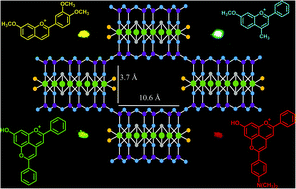Highly fluorescent hybrid pigments from anthocyanin- and red wine pyranoanthocyanin-analogs adsorbed on sepiolite clay†
Abstract
Flavylium cations serve as models for the chemical and photochemical reactivity of anthocyanins, the natural plant pigment responsible for many of the red, blue and purple colors of fruits and flowers. Likewise, pyranoflavylium cations serve as models of the fundamental chromophoric moiety of pyranoanthocyanins, molecules that can form from reactions of grape anthocyanins in red wines during their maturation. In the present work, hybrid pigments are prepared by the adsorption of a series of five synthetic flavylium cations (FL) and five synthetic pyranoflavylium cations (PFL) on sepiolite clay (SEP). The FL are smaller in size than the PFL, but both can in principle fit into the tunnels and/or external grooves (with dimensions of 3.7 × 10.6 Å) of SEP. Measurements of the fluorescence quantum yields of the adsorbed dyes indicate that they are at least as fluorescent as in acidic acetonitrile solution, and in a few cases substantially more fluorescent. The observation of biexponential fluorescence decays is consistent with emission from dye molecules adsorbed at two distinct sites, presumably tunnels and grooves. These hybrid materials also have improved properties in terms of stability of the color in contact with pH 10 aqueous solution and resistance to thermal degradation of the dye. SEP thus appears to be a promising substrate for the development of highly fluorescent flavylium or pyranoflavylium cation-derived hybrid pigments with improved color and thermal stability.



 Please wait while we load your content...
Please wait while we load your content...